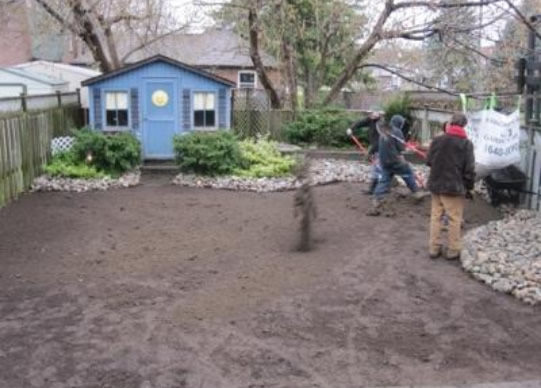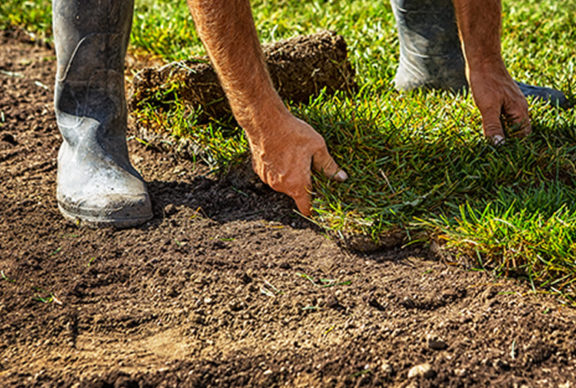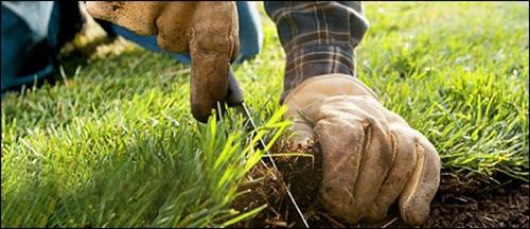Sod Installation
Cultivated turf allows you to enjoy a lawn of instant beauty and maturity without the usual time-consuming hassles of seeding. The following are the basic steps to a beautiful lawn.
STEP 1 – Measuring and Ordering
With a tape, measure the area of your planned lawn. Include these measurements on a sketch of the lawn area, with the length, width, and any unusual features. If your lawn is not a perfect square or rectangle, the easiest way to determine how much sod you need is to break your lawn into regular shapes and measure the area of each shape individually. For example Fairgreen Sod will be happy to determine the amount of turfgrass sod you will need from your sketch. Each roll of sod is 2 feet by 4.5 feet and covers an area of 9 square feet.
Schedule your order for delivery of turf after preparatory work is completed and you are ready to install. Fairgreen offers next day delivery; so once all your prep work is complete just give us a call. Prompt installation on the day of delivery is crucial to a strong beginning for your lawn. Sod left on a skid will not last more than 6 hours in the summer heat.
STEP 2 – Soil Preparation
Clear the site of all building materials (wood, cement, bricks, etc.), as well as any buried stumps, rocks, stones or other debris that is larger than 4-5 cm (2-3 inches) in diameter.
Rough grade the entire area to eliminate any drainage problems on the property. This would include sloping the grade away from building foundations, eliminating or reducing severe slopes and filling low-lying areas. A tractor-mounted blade and/or box are most often used for rough grading, but if the area is smaller, it can be done with hand tools. The rough grading will probably uncover more debris that should be removed and not buried.
Initial tilling, to a depth of at least 5 cm (2 inches), should be completed prior to adding any topsoil or soil amendments. This will control most annual weeds, alleviate subsoil compaction and permit a bonding of the topsoil to the subsoil and improve root penetration and water movement.
Add topsoil to achieve a total topsoil depth of 10-15 cm (4-6 inches), after firming. The topsoil should be a loamy sand, sandy loam, clay loam, loam, silt loam, sandy clay loam or other soil suitable for the area. To the extent possible, practical, affordable and available, incorporate humus (fully decomposed organic matter) into the topsoil.
Finish grade the entire site, maintaining the rough grading contours and slopes, with a tractor-mounted box blade on large areas or heavy-duty rake on smaller sites.

Roll the area with a lawn roller one third full of water to firm and settle the surface and reveal any low spots that should be filled to match the surrounding grade surface. If time permits, allow the area to settle further with rainfall or by applying irrigation water.
This site is now ready for turfgrass sod. With this degree of careful and thoughtful soil preparation, the resultant lawn will be absolutely beautiful and require less maintenance and smaller quantities of applied water, and fertilizer, as it maintains a high degree of density and uniformity and recovers much more rapidly from wear. For years to come, your investment in soil preparations will yield a high return.
STEP 3 – Turf Installation
Install your lawn immediately upon delivery of fresh sod. Begin watering your new lawn within 30 minutes of installation. Turf is a living plant that requires ground contact and moisture to survive!
Begin installing turf along the longest straight line, such as a driveway or sidewalk. Butt and push edges and ends against each other tightly, without stretching. Avoid gaps or overlaps. Stagger the joints in each row in a brick-like fashion, using an exacto knife to trim corners, etc. Avoid leaving small strips at outer edges as they will not retain moisture. On slopes, place the turf pieces across the slope.
To avoid causing indentations or air pockets, avoid repeated walking or kneeling on the turf while it is being installed or just after watering.
After installing the turf, roll the entire area to improve turf/soil contact and remove air pockets.

STEP 4 – Watering
Give your new lawn at least 2 to 3 cm. (1 in.) of water within 1/2 hour of installation. Water daily, or more often, keeping turf moist until it is firmly rooted (about 2 weeks). Then less frequent and deeper watering should begin.
Weather conditions will dictate the amount and frequency of watering. Be certain that your new lawn has enough moisture to survive hot, dry, or windy periods. Water areas near buildings more often where reflected heat dries the turf.
Caution:
During the first three weeks, avoid heavy or concentrated use of your new lawn. This gives the roots an opportunity to firmly knit with the soil, and ensures that the turf will remain smooth.

STEP 5 – Enjoy
Your new sod lawn increases your property value significantly. With proper care, it will remain a great asset, providing beauty, a clean playing surface, and an improved environment.
Maintenance:
Mow often, generally removing no more than 1/3 of the grass height at a mowing. Keep your mower blade sharp. Fertilizer applications will depend on climate, sod type, soil, insects, weed and disease conditions.
(Some information courtesy of Turfgrass Producers International)

Quick Facts
There is no better time to enhance a lawn’s ultimate beauty and success than by improving the soil before any planting takes place.
Benefits of Proper and Complete Soil Preparation
- Improved Uniformity
- Increased Density
- Faster recovery from wear
- Reduced Use of Water, & Fertilizer
- Reduced Maintenance

Quick Fact: Why Is Good Soil Important?
For optimum growth, turfgrass needs just four things (in the proper balance) to grow…sunlight, air, water and nutrients. Reduce any of these, or provide too much of any one, and the grass may die or suffer. In the right proportions, the grass will flourish, providing not only beauty to the landscape, but also a clean and safe place to play and many benefits to the environment.
Grass obtains three of these four essential factors (air, water and nutrients) from the soil, but many soils are less than ideal for growing grass. Some soils contain too much clay and may be very compacted… great for roads, bad for grass, because air and water aren’t available to the roots and the roots can’t grow. Other soils may have too much sand… beautiful on a beach, but difficult to grow grass because water and nutrients won’t stay in the root zone long enough for the plant to use. Another frequently observed problem with many soils is that its pH (the degree of acidity or alkalinity) is too high or too low for optimum grass growth.
Quick Fact: What Is The Best Soil For Turfgrass?
A sandy loam soil with a pH of 6.0 to 7.0 is the best soil for producing a beautiful, high-use, low-maintenance lawn. Unfortunately, this ideal soil mixture is seldom found on any property after construction.
Quick Fact: How Deep Should the Soil Be For Turfgrass?
The absolute minimum quality soil depth for a care free lawn is 10 cm (4 inches); however, for deeper root penetration and the benefits that brings, the accepted standard is 15 cm (6 inches).
Quick Fact: Can Soils Be Improved?
Practically without exception, not only can most soils be improved, they usually need to be improved to get the maximum results.
The knowledge of what’s necessary, the amount and availability of materials and the immediate costs of time and money are the factors that typically deter people from taking the steps necessary to improving the soil. While some people do not fully understand the importance of good soils for grass, many also believe they can save time and money by ignoring the need to improve their lawn’s soil.
The fact is that failing to improve the soil before planting is only inviting a much greater and continual investment of both time and money, that will never return its value as fully as preparing the soil properly before planting any grass.
Site Preparation Steps
“The beauty is in the blades, but the ‘action’ is in the roots,” is a good adage to remember when growing grass. Thus, the value of proper site preparation and soil improvement, before any planting takes place, is that it will be easier for the grass roots to penetrate deeply and evenly. Deep roots will make the lawn more drought resistant, a more efficient water and nutrient user and more dense as new grass plant shoots emerge. A dense lawn crowds out weeds and better resists insects and disease.
Follow these steps for a beautiful, healthy and trouble-free lawn. Think Green call Fairgreen Sod Farms at 905-640-9090, 10378 Hwy 48 Markham Ontario
